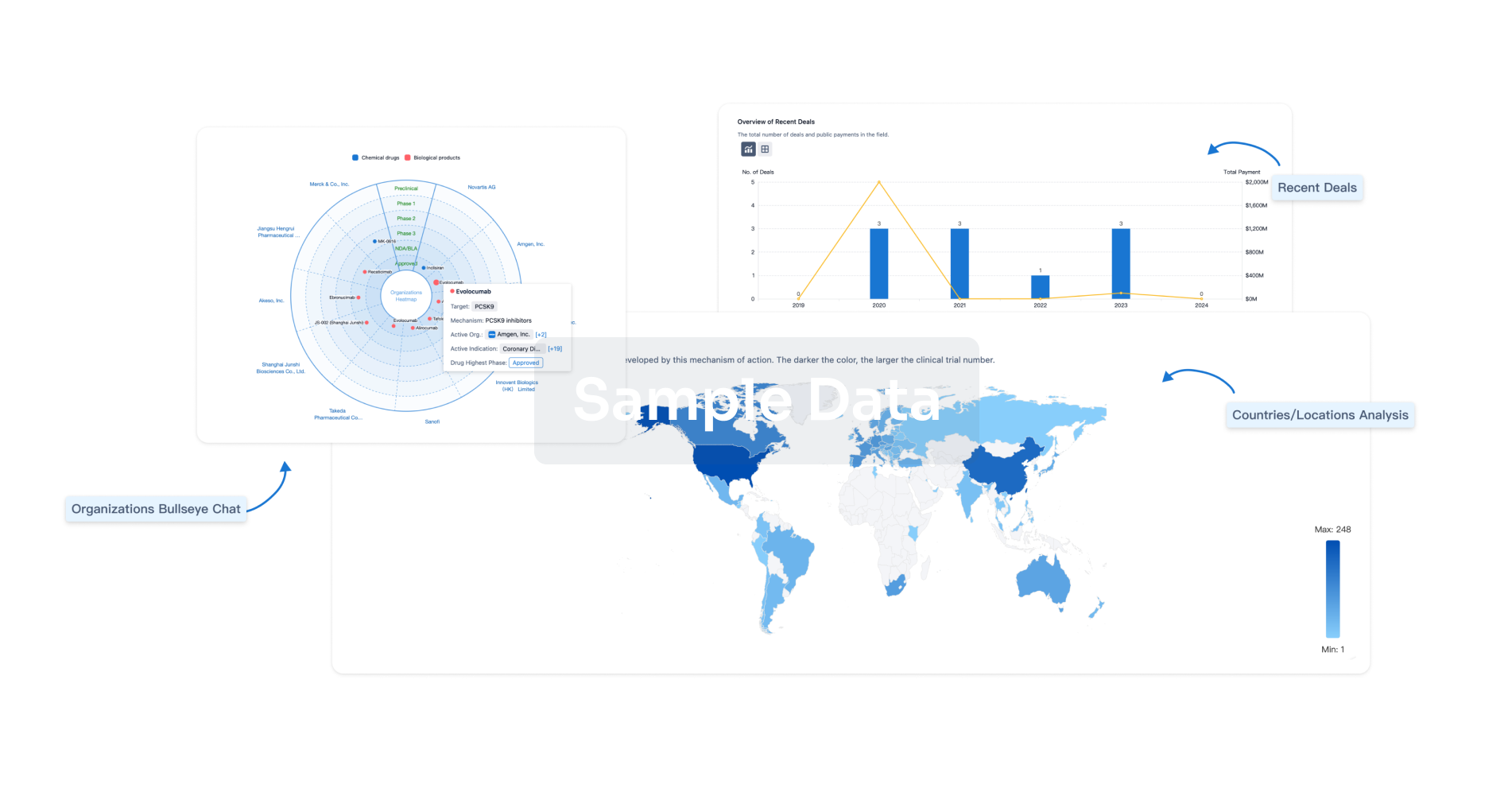Request Demo
Last update 08 May 2025
CDK13 x CDK12
Last update 08 May 2025
Related
22
Drugs associated with CDK13 x CDK12Target |
Mechanism Cyclin-K degraders [+2] |
Active Org. |
Originator Org. |
Active Indication |
Inactive Indication- |
Drug Highest PhasePhase 1/2 |
First Approval Ctry. / Loc.- |
First Approval Date20 Jan 1800 |
Target |
Mechanism CDK12 inhibitors [+1] |
Active Org. |
Originator Org. |
Active Indication |
Inactive Indication- |
Drug Highest PhasePreclinical |
First Approval Ctry. / Loc.- |
First Approval Date20 Jan 1800 |
Target |
Mechanism CDK12 inhibitors [+1] |
Active Org. |
Originator Org. |
Active Indication |
Inactive Indication- |
Drug Highest PhasePreclinical |
First Approval Ctry. / Loc.- |
First Approval Date20 Jan 1800 |
10
Clinical Trials associated with CDK13 x CDK12NCT06600789
A Modular, Multi-Part, Multi-Arm, Phase 1/2 Study to Evaluate the Safety and Tolerability of CT7439 Alone and in Combination with Anticancer Treatments in Participants with Solid Malignancies
This modular, multi-part, multi-arm, Phase 1/2, FIH study allows the evaluation of the safety and tolerability of CT7439, dosed as a monotherapy and in combination with anticancer treatment in participants with solid malignancies.
Start Date16 Aug 2024 |
Sponsor / Collaborator |
NCT02656849
A Phase II Study of BAY 1000394 in MCL1-Amplified, MYC-Amplified, CCNE1-Amplified Tumors
This research study is studying whether a new experimental cancer study drug BAY 1000394 will be helpful in treating solid tumor cancer with an abnormality in one of the following genes: Mcl-1, Myc or CCNE.
Start Date01 Feb 2016 |
Sponsor / Collaborator |
NCT02522910
An Open-label Phase Ib/II Study of BAY 1000394 (Roniciclib) in Combination With Docetaxel in Second- or Third-line Treatment of Patients With Advanced Non-small Cell Lung Cancer (NSCLC)
This study part will be conducted in an open-label, non-randomized, Phase I conventional 3+3 dose-escalating design to define the safety, tolerability, pharmacokinetics, and MTD of BAY 1000394 (Roniciclib) given in a 3 days on / 4 days off schedule in combination with docetaxel in subjects with second- or third-line NSCLC.
Start Date01 Aug 2015 |
Sponsor / Collaborator |
100 Clinical Results associated with CDK13 x CDK12
Login to view more data
100 Translational Medicine associated with CDK13 x CDK12
Login to view more data
0 Patents (Medical) associated with CDK13 x CDK12
Login to view more data
49
Literatures (Medical) associated with CDK13 x CDK1201 Apr 2025·European Journal of Medicinal Chemistry
Discovery of novel imidazo[1,2-b]pyridazine derivatives as potent covalent inhibitors of CDK12/13
Article
Author: Tang, Lei ; He, Yongchang ; Huang, Siqi ; Gu, Shuangxi ; Luo, Cheng ; Ding, Hong ; Xia, Meng ; Li, Ziteng ; Hu, Linghao ; Li, Yuanqing ; Wang, Mingliang ; Jiang, Hanrui
27 Mar 2025·Journal of Medicinal Chemistry
Discovery of YJZ5118: A Potent and Highly Selective Irreversible CDK12/13 Inhibitor with Synergistic Effects in Combination with Akt Inhibition
Article
Author: Ren, Xiaomei ; Ervine, Grafton ; Zhou, Yang ; Ding, Ke ; Chang, Yu ; Zhou, Licheng ; Huang, Weixue ; Yang, Jianzhang ; Mannan, Rahul ; Zhou, Kaijie ; Zhang, Pujuan ; Wang, Zhen ; Hamadeh, Rudana ; Tien, Jean Ching-Yi ; Zhang, Yuping ; Chinnaiyan, Arul M. ; Wang, George Xiaoju ; Mahapatra, Somnath ; Liu, Wenyan
01 Mar 2025·Cell Death & Differentiation
Physiological and pathological roles of the transcriptional kinases CDK12 and CDK13 in the central nervous system
Review
Author: Sette, Claudio ; Pagliarini, Vittoria ; Pitolli, Consuelo ; Marini, Alberto
1
News (Medical) associated with CDK13 x CDK1202 Oct 2024
SALT LAKE CITY, UT, USA I October 02, 2024 I
Recursion (NASDAQ: RXRX), a leading clinical stage TechBio company decoding biology to industrialize drug discovery, today announced that the U.S. Food and Drug Administration (FDA) has cleared an investigational new drug (IND) application for a Phase 1/2 clinical trial of REC-1245, a new chemical entity for the treatment of biomarker-enriched solid tumors and lymphoma.
Chris Gibson, Ph.D., Co-founder and CEO of Recursion said, “REC-1245 is a prime example of using an expansive AI-enabled platform for drug discovery. After exploring many predicted biological and chemical relationships across our maps of biology, we identified RMB39 as a novel target that looks functionally similar to the well-known but hard to drug target CDK12. We also identified and optimized small molecules that target RBM39 without directly impacting CDK12 or CDK13 using these same AI-enabled maps.
In under 18 months
, leveraging some of our newer chemistry tools, Recursion rapidly progressed REC-1245 from novel target biology to preclinical drug candidate, more than twice the speed of industry average.”
Recursion identified the novel regulatory role of RBM39 associated with CDK12 using its maps of biology and first reported this relationship in early 2023 at Download Day, Recursion’s R&D and investor event. Recursion believes the modulation of RBM39 may be associated with a therapeutic effect in certain biomarker-enriched solid tumors and lymphoma. Additionally, Recursion estimates that the initially addressable population for this potential therapeutic to be >100,000 patients in the US and EU5. REC-1245 is a potent and selective RBM39 degrader with a potential first-in-class profile. Preclinical data support that RBM39 degradation induces splicing defects which downregulate DNA Damage Response (DDR) networks and cell cycle checkpoints.
“RBM39 degraders may offer a promising therapeutic approach for patients with solid tumors, particularly those with limited treatment options,” said Najat Khan, Ph.D., Chief R&D Officer and Chief Commercial Officer at Recursion. “Recursion’s platform was among the first to rapidly uncover the therapeutic potential of RBM39 degradation, a finding now validated by independent research. This mechanism provides new opportunities for targeting tumors, which are often resistant to conventional treatments. By advancing this research, we aim to deliver a critical option for patients facing significant unmet needs, ultimately improving their prognosis and quality of life.”
The Phase 1/2 clinical trial will evaluate the safety, tolerability, pharmacokinetics, pharmacodynamics, and potential monotherapy efficacy of REC-1245, and is expected to initiate in Q4 2024.
About Recursion
Recursion (NASDAQ: RXRX) is a clinical stage TechBio company decoding biology to industrialize drug discovery. Enabling its mission is the Recursion OS, a platform built across diverse technologies that continuously expands one of the world’s largest proprietary biological and chemical datasets. Recursion leverages sophisticated machine-learning algorithms to distill from its dataset a collection of trillions of searchable relationships across biology and chemistry unconstrained by human bias. By commanding massive experimental scale — up to millions of wet lab experiments weekly — and massive computational scale — owning and operating one of the most powerful supercomputers in the world, Recursion is uniting technology, biology and chemistry to advance the future of medicine.
Recursion is headquartered in Salt Lake City, where it is a founding member of BioHive, the Utah life sciences industry collective. Recursion also has offices in Toronto, Montréal, London, and the San Francisco Bay Area. Learn more at
www.Recursion.com
, or connect on
X
(formerly Twitter) and
LinkedIn
.
SOURCE:
Recursion Therapeutics
INDClinical Study
Analysis
Perform a panoramic analysis of this field.
login
or

AI Agents Built for Biopharma Breakthroughs
Accelerate discovery. Empower decisions. Transform outcomes.
Get started for free today!
Accelerate Strategic R&D decision making with Synapse, PatSnap’s AI-powered Connected Innovation Intelligence Platform Built for Life Sciences Professionals.
Start your data trial now!
Synapse data is also accessible to external entities via APIs or data packages. Empower better decisions with the latest in pharmaceutical intelligence.
Bio
Bio Sequences Search & Analysis
Sign up for free
Chemical
Chemical Structures Search & Analysis
Sign up for free




